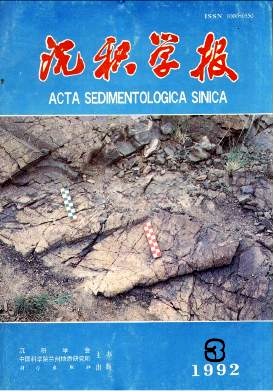Paleokarst Cave Phosphorites of the Upper Sinian Dengying Formation in Southern China
- Publish Date: 1992-09-10
Abstract: The Upper Sinian Dengying Formation of Yangtze region is subdivided into the Lower and Upper members, between both the parallel unconformity occurs commonly. Recently, the paleokarst cave phosphorites are found in the upper part of the Lower member dolostones of the Dengying Formation at the southern and northern margins of Western Hubei Platform which is a subordinate unit of the Great Yangtze Platform (Text-fig. 1 and 2). At Wangjiabao area, Nanzhang County, located in the northern margin of Western Hubei Platform, the paleokarst cave phosphorites range from the eroded surface between the both members of the Dengying Formation downwards to 70 m and consist of phosphorite and dolostonedetritus, terrigenous sands and clay minerals, disorderly or laminatedly. A bed of phosphorites, about 2 m in thickness, composed of intraclastic phosphorite (PI. Ⅱ , 14) , oncoid and laminated algal phosphorite, and phosphorous conglomerate, sandstone and mudstone or shale, extends on the eroded surface. This horizon of the paleokarst caves was formed because of exposure of the platform margin into land at the end of Early Dengying age, whereas the filling process took place in the beginning time of later Dengying trans gression. At Zhangjiaxi of Dayong County situated in the southern margin of the platform, the lower member of the Dengying Formation is overlaid with the Niuditang Formation black shale of the lower Cambrian for lack of the upper member. Usually, a thin bed of phosphorites occurred at the base part of the Niudrtang Formation black shale, several to tens of centimeters in thickness, commonly bearing collophanite lumps, concretions and intraclasts, in which Protospongia spicules and endolithic algal or fungous borings (5 to 10 μm in diameter) are very abundant locally. A sink hole is found. It spreads from the eroded surface downwards into the lower member dolostones of the Dengying Formation and is filled with the Niuditang Formation shale and phosphorites (PI. Ⅰ , 1). The paleokarst caves distribute in the upper part of the Lower member dolostones of the Denying Formation in horizon, and are filled with phosphorite and dolostone clasts, sometimes with laminated algal phosphorite and barite layer in some of large caves (PI. Ⅰ 2). Poorly preserved filaments and coccoids of blue-green algae (PI. Ⅰ , 3 and 4) are occasionally seen in the algal phosphorite, while endolithic algal borings (15 to 50 μm in diameter) filled with dolomite can be frequently found (PI. Ⅰ , 5 and 6). The skeleton-like fragment also occurs in the collophanite layer deopsited within paleokarst cave (PI. Ⅱ, 13).Obviously, this horizon of paleokarst cave phosphorites was formed in the early stage of Early Cambrian. The formative stages of the paleokarst cave phosphorites at Zhangjiaxi seem as follows: (1) the margin of the coarbonate platform elevated and exposed subaerially to form paleokarst caves under warm and moist condition; (2) the algal carbonate sediments developed on the sea bottom and in some of large karstcaves when the platform subsided and was covered with shallow seawater; (3) phosophorous solution carried by upwelling current rapidly replaced the algal carbonate sediments or precipitated in phosphanite on the sea bottom; (4) endolithic algal borings and burrows occurred in the phosphate sediments; (5) phosphate and dolomitic debris, came from the phosphate deposits on the sea bottom and from the lower member dolostones of the Dengying Formation which are the country rock of the paleokarst caves and the fundamental of Late Dengying and Early Cambrian intergressions, filled within the paleokarst caves; (6) dolosparite cements precipitated in the birdseye-like pores, the burrows (PI. Ⅱ, 11) and the remainder intergrain pores; (7) barite precipitated in the cave spaces remaining open after dolomite cementation, or sedimented in layer in the caves which had been not full filled. The above evidences show that two crustal movements arose respectively at the ends of Early Dengying age and of Sinian to cause the formations of pale
| Citation: | Xue Yaosong, Tang Tianfu, Yu Congliu. Paleokarst Cave Phosphorites of the Upper Sinian Dengying Formation in Southern China[J]. Acta Sedimentologica Sinica, 1992, 10(3): 145-153. |






 DownLoad:
DownLoad: